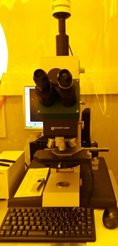Chemistry and lithography area
(outside clean room)
SUSS Microtec MA6 Mask Aligner (UV4)
(ceiling fan class 100)
Karl Süss MJB3 Mask Aligner
(ceiling fan class 100)
Karl Süss RC8 Gyrset Spinner
(resin spreading hood)
SUSS Labspin 6 Spinner
(resin spreading hood)
SPS POLOS SPIN150i Spinner
(sample cleaning)
Class 100 laminar flow hoods
Sample cleaning and developmentResin spreading
Chemical treatment
Etching area
high density plasma ion etching
ICP-RIE Corial 210IL frame
high density plasma ion etching
Deposition area
deposition by electron gun
RIBER
Joule deposition by evaporation
MRC
sputter deposition
Heat treatment
Characterization
Hybrid electronic lithography equipment: a Zeiss SEM Supra 40 with a Raith ELPHY Plus system
(outside clean room - contact : Viginie Brändli)
Direct writing with an electron beam allows us to reproduce patterns on a sample through an electrosensitive resin. This system supplements the optical lithography when one wants to reach submicron sizes for example.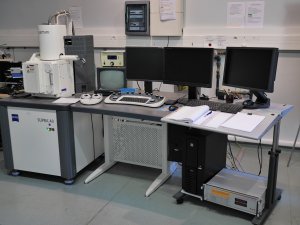
Specifications :
- Acceleration voltage 0.5kV to 30kV
- Maximum Writing field : 1x1mm
- Manual alignment
- Ultimate resolution : 20nm
- Size samples: from a few mm up to 3’’
SUSS Microtec MA6 mask aligners (UV 400)
(installed under ceiling fan class 100)
Photolithography makes it possible to reproduce, with an alignment of precision, the patterns of an optical mask (quartz mask with patterns, opaque, in chrome), on a sample, through the median a photosensitive resin.
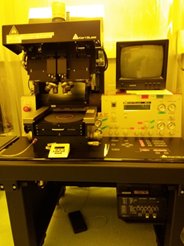
Specifications :
- UV Hg lamp (350W) broadband
- TSA alignment (front panel)
- Resolution :
- Vacuum chamber < 0.8
- Hard contact : Mechanical pressure + jet pressure nitrogen < 1.5
- Soft contact : Mechanical pressure < 2.5
- Proximity < 3
- Alignment precision : 0.5µm
- Masks size: 4’’ - 5’’
- Samples size: from a few mm up to 100mm substrate
Aligners Karl Süss MJB3
(installed under ceiling fan class 100)
Karl Süss Aligner is a versatile, fully manual machine Easy to use, allowing the process of size samples and very varied thicknesses.
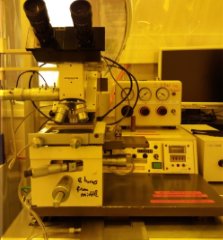
Specifications :
- UV Hg lamp (200W) broadband
- Resolution :
- Vacuum chamber < 0.8
- Hard contact : Mechanical pressure + jet pressure nitrogen (1µm)
- Soft contact : Mechanical pressure (2µm)
- Alignment precision : 1µm
- Masks size: 2’’ - 4’’
- Samples size: from a few mm up to 2’’ substrate
Karl Süss RC8 Gyrset Spinner
(installed under ceiling fan class 100)
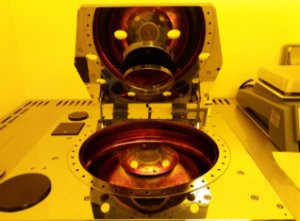
Specifications :
- Gyrset system
- Samples size : Until 3’’ substrate
- Manual alignment
- Speed : 10 – 6000 rpm
- Acceleration : 100 to 5000 rpm/sec
TSUSS Labspin 6 Spinner
(installed under ceiling fan class 100)
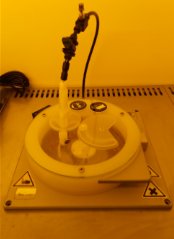
Specifications :
- Samples size : Substrate up to 150mm in diameter or square samples 4" x 4"
- Speed : 0 rpm - 8000 rpm
- Acceleration : 0 - 4000 rpm/sec
POLO SPIN150i Spinner
(installed under ceiling fan class 100)
SPIN150i POLO spinner is used for cleaning samples and cleaning optical masks.
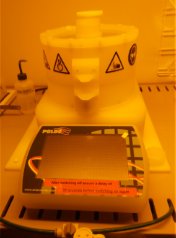
Specifications :
- Samples size : Substrate up to 150mm in diameter or square samples 4" x 4"
- Speed : 0 rpm - 12000 rpm
- Acceleration : 0 - 30000 rpm/sec
- Direction of rotation: clockwise, counterclockwise, alternating
Hood for cleaning samples and development
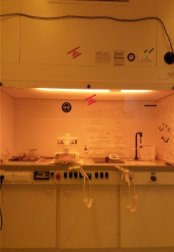
Specifications :
- Class 100
- Inactinic light
- Bac à ultrasons
- Rinsing deionized water (18 MΩ)
- Tray with resistivity meter
- Hot plates
Detergent :
- TFD4
solvents :
- Biosane SR 84 to be replaced by Neutralene 2015
- Acetone
- Propan-2-ol
- Ethylene glycol
- MIBK/IPA
- AR600-546
- Remover PG, Ni555, ZDMAC
- AZ EBR solvent
Bases :
- Primers :
- Hexamethyldisilazane (HMDS)
- Ti Prime
- Developers :
- Tetramethylammonium hydroxide (TMAH) :
- AZ726MIF
- AZ826MIF
- MICROPOSIT MF319
- AR 300-40
- AR 300-47
- Potassium hydroxide (KOH) :
- AZ 400 K
- Tetramethylammonium hydroxide (TMAH) :
Resin spreading
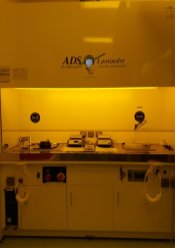
Specifications :
- Class 100
- Inactinic light
- Bac à ultrasons
- Rinsing deionized water (18 MΩ)
- Tray with resistivity meter
- Hot plates
Solvents :
Résines :
- AZ5214E reversible (UV)
- AZ4533 positive (UV)
- AZ4562 positive (UV)
- AZ2070 nlof negative (UV)
- AZ ECI 3012 (Development) (UV)
- S1805 positive (UV)
- Remover PG, Ni555, ZDMAC
- S1808 positive (UV)
- AR-P6200/CSAR positive (electronic)
- AR-N 7500-18 negative (electronic)
- 495 PMMA A4 positive (electronic)
- 950 PMMA A2 positive (electronic)
Hood for chemical treatment

Specifications :
- Class 100
- Inactinic light
- Bac à ultrasons
- Rinsing deionized water (18 MΩ)
- Tray with resistivity meter
- Hot plates
Acides :
- Hydrofluoric acid HF 50%
- Hydrofluoric acid HF 47-51%
- Buffered oxide etch (B.O.E.) 7.1
- Sulfuric acid H2SO4 96%
- Hydrochloric acid HCl 37%
- Nitric acid HNO3 70%
- Phosphoric acid H3PO4 85%
- Citric acid monohydrate
- Acetic acid CH3COOH 100%
- Chrome etch 18
- Gold ecth
Bases :
- Potassium hydroxide KOH 45%
- Ammonia NH4OH 30%
- Sodium hydroxide NaOH (solide)
- Gallium Phosphide Etch
- Tetramethylammonium hydroxide (TMAH)
- Hydrogen peroxide H2O2 30%
RIE Oxford System 100 high density plasma ion etching with ECR 180
This is a physico-chemical etching because it involves both an
ion bombardment and a chemical reaction between the ionized gas
(plasma) and the surface of the sample.
Compared to a "traditional" RIE, the RIE-ECR (see diagram 2) has
a high density plasma (because of the microwave source), a plasma
with low potential and low ion energies at low pressure due to the
magnetic confinement of the electrons (source ECR).
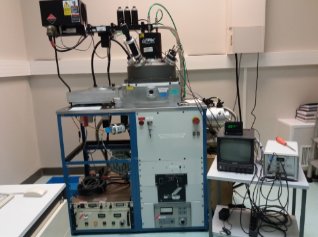
Specifications :
- Turbomolecular pumping: few vacuum 10-7 mbar
- Entry lock
- Gas lines : C12, CH4, Ar, O2, H2, SF6
- Capacity : 2 '' substrate (and up to 100mm)
- Engraved materials : GaN, AlGaN, AlN, SiC, SiO2, Si, ZnO, ZnMgO…
- In-situ control of engraved thickness
High density plasma etching ICP-RIE Corial 210IL
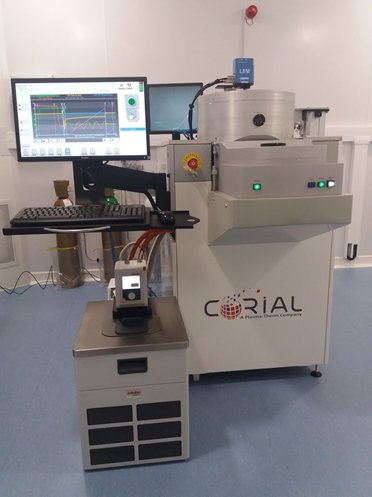
Specifications :
- Turbomolecular pumping
- Gas lines : HBr, BCL3, Cl2, CHF3, C4F8, CH4, SF6, O2, Ar, H2, N2
- Engraved materials : GaN, AlGaN, AlN, SiC, SiO2, Si, ZnO, ZnMgO, AL2O3…
- In-situ control of engraved thickness
Evaporator with electron gun Alliance Concept EVA 450
The material to be deposited is evaporated following a localized bombardment high energy electrons generated by a tungsten filament (electron gun).
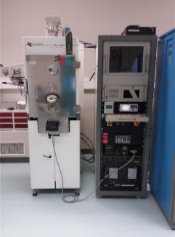
Specifications :
- Cryogenic pumping: vacuum limit of some 10-8 mbar
- Entry lock
- Quartz scale giving access to the deposited thickness
- Capacity : substrate up to 100mm
- Engraved materials : Ti, Al, Ni, Au, Ag, Pt, Ge, Mo…
- Dielectrics : SiO2.
RIBER Joule effect evaporator
The material to be deposited is evaporated by passing a current high intensity through a tungsten crucible.
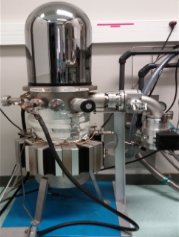
Specifications :
- Turbomolecular + ionic pumping: vacuum limit of some 10-7 Torr
- Quartz scale giving access to the deposited thickness
- Capacity : substrate up to 100mm
- Maximum current : 250A
- Metals : Ti, Al, Ni, Au, Cr, Si, In, Pd, Ge…
Pulvérisation Cathodique MRC
The material to be deposited is pulverized following an ion bombardment
Ar +, resulting from a plasma Ar, following the acceleration imposed
by the electric field between the target and the sample. The particles
are usually electrically neutral, and are broadcast in the enclosure
to deposit on the substrate.
The "etch" mode can also be used for engraving or surface preparation
prior to deposition.
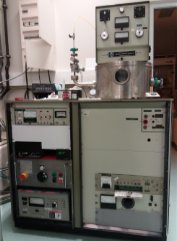
Specifications :
- Turbomolecular pumping: limit vacuum ~7x10-6 Torr
- Quartz scale giving access to the deposited thickness
- Capacity : 2 '' substrate (and up to 100mm)
- Metals : Mo, Ta, W, Al…
- Insulation : SiO2, Si3N4, Ta2O5, Nb2O5, Cr2O3...
Fast annealing oven Jipelec Jetfirst 100
The annealing furnace allows very short thermal annealing a few seconds (for the broadcast of the process contacts) minutes (reorganization of the epitaxial layers).
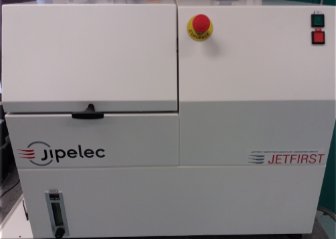
Specifications :
- Dedicated external computer programming
- Annealed under: vacuum, or under atmosphere (N2, O2)
- Graphite susceptor covered with SiC
- Sample size : up to 100 mm
- Halogen lamps: 2 zones of 6 lamps
- Maximum temperature : 1300°C
- Temperature measurement (thermocouple K and optical pyrometer)
- Purge line : N2
Memmert UN30Plus drying oven
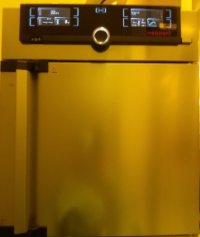
Specifications :
- Programmable (ramp and landing)
- Maximum temperature : 300°C
Veeco Dektak 8 profilometer
The Veeco Dektak 8 profilometer is an extremely interesting tool for the development of components since it allows the measurement of steps resins, metals or engraved depths. This equipment also allows for constraint measurements through the analysis of the curvature of platelets as well as 3D measurements. The position the head is fully programmable and allows to check the homogeneity a process on the entire surface of a wafer (up to 200mm).
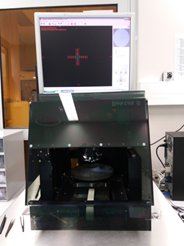
Specifications :
- Table size: 200 mm
- Max vertical resolution: 1 Å
- Vertical measurement range : 262µm
- Sweeping length : 50µm-50mm
- Stylus support force : 1 mg-15 mg
Since 2009, the technology center is part of the CT-PACA technology platform, which brings together CRHEATEC (CRHEA), PLANETE (CINAM-Marseille) and NANOTECMAT (IN2MP-Marseille), offering services to academic actors (including INPHYNI) and industry. CRHEATEC is also used by a spin-off, Klearia, hosted at CRHEA since early 2018, for microfluidic glass applications. The technological center also aims at training students from universities and schools engineers interested by microelectronics techniques.

